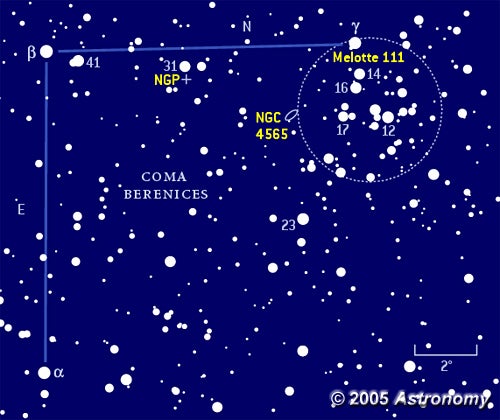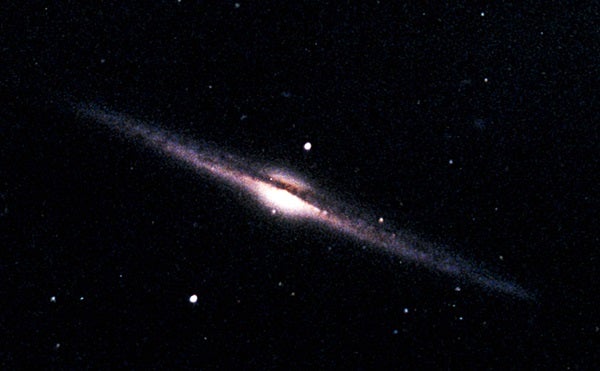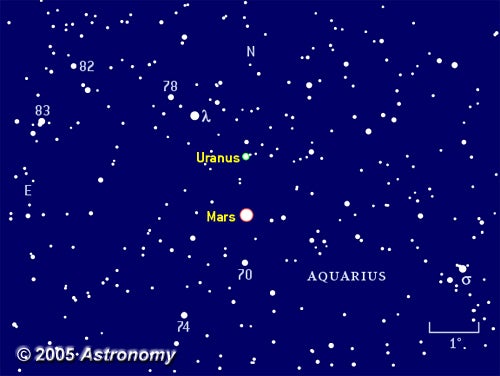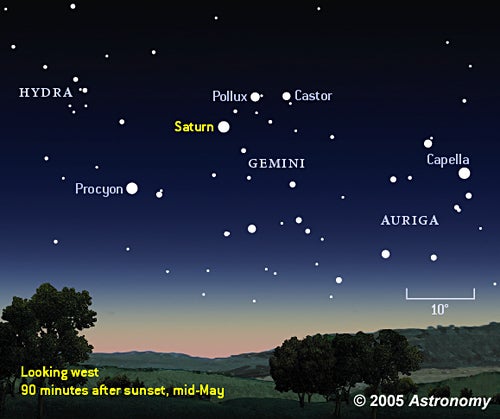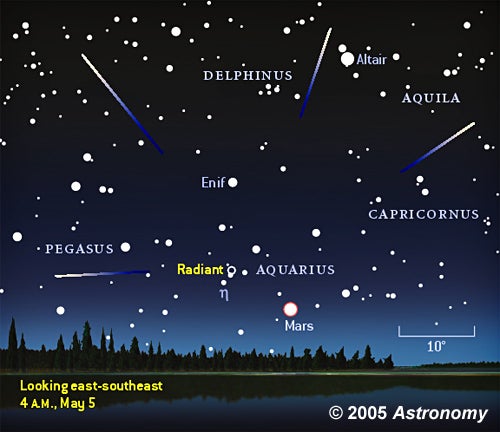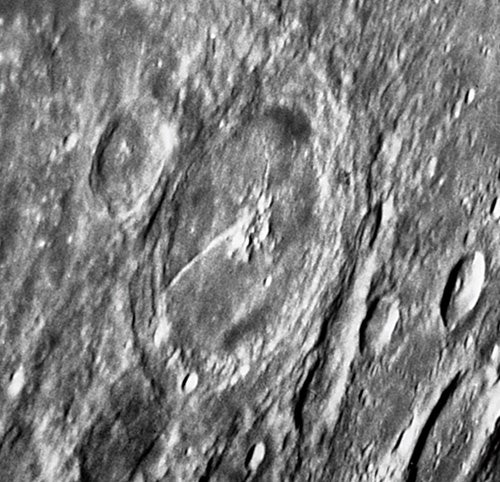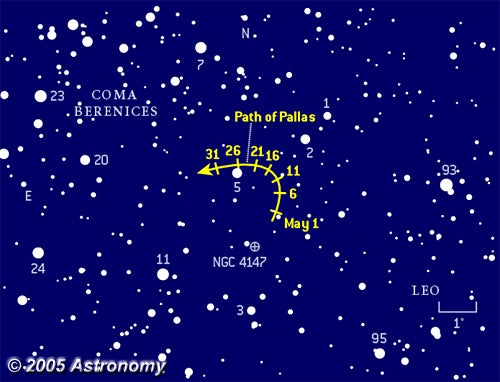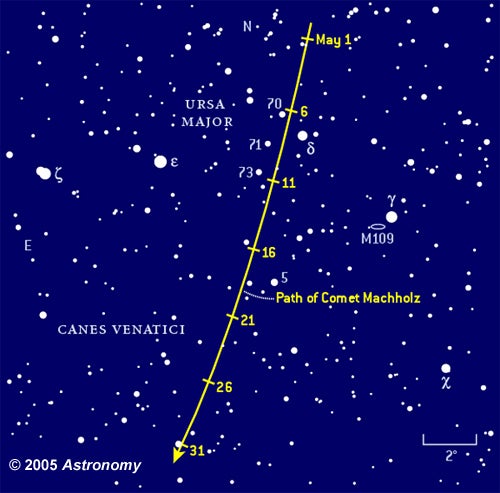One consequence of the motion in our neighborhood is the ever-changing shadow-play of planets, moons, and asteroids. Saturn owes at least some of its appeal to the 3-D appearance it gains when the planet’s shadow falls on the rings. Get a good look at Saturn now — by the end of June, it will be lost in the Sun’s glare.
The Galilean moons of Jupiter also entertain as they travel around the planet. Just about every other night, one of the moons casts an ink-black shadow onto the gas giant’s swirling cloud tops. A handful of times each month, two moons simultaneously cast shadows on Jupiter. The two best events for North American observers this month come the evenings of May 19 and 26.
The first reasonably accurate estimate of the speed of light came in the 1600s, when Danish astronomer Ole Rømer timed similar shadow events when Jupiter was different distances from Earth. The flip side to watching the Galilean moons’ clockwork rhythms comes in observing a moon slowly emerge from, or disappear into, Jupiter’s shadow.
Stars regularly cast the Moon’s shadow onto Earth. Usually, we think of it the other way around — as the Moon hiding a star — and call the phenomenon an occultation. The best event this month happens the morning of May 24 and involves the red supergiant star Antares. This star is so bloated that instead of vanishing instantaneously behind the lunar limb as most stars do, it fades quickly.
Some of the most dramatic shadows are cast by the mountains and crater rims of the lunar surface. Pick any time a couple of days from Full Moon (May 23) and look closely at the terminator, the line that divides darkness from light. Find a shadow next to an obvious feature, then come back every 10 minutes or so to see how much it has retreated. After full phase, the shadows grow longer.
The best views of the night sky come from locations far removed from the light pollution of big cities. From the countryside, a small telescope can deliver a nice view of Comet C/2004 Q2 (Machholz). Watch Machholz over the course of May, as it slowly crosses the Big Dipper’s handle. The comet glows around 9th magnitude, brighter than most of the distant galaxies that pepper this region of sky.
Dust freed from a comet’s dirty-snowball surface forms a yellow-white tail. With each passage around the Sun, a periodic comet like 1P/Halley slowly spreads a stream of microscopic debris along its orbit. If Earth cuts across this path, the tiny meteoroids blaze trails across the sky, collectively creating a meteor shower. That’s what happens in the predawn hours of May 4/5, when the dusty children of Comet Halley produce the Eta Aquarid meteor shower. Under a dark sky, expect to see 10 to 20 meteors per hour. The waning crescent Moon will not interfere much.
Known since the days of antiquity, the Coma Star Cluster is one of the sky’s most beautiful sights. This delightful group
of stars, cataloged as Melotte 111, has been associated with several stories and myths through the ages. In the third century b.c., Greek astronomer Eratosthenes dubbed the group “Ariadne’s Hair,” after the courageous princess who helped Theseus find his way back through the maze after slaying the Minotaur.
From a rural site, this slightly misty collection of a dozen stars draws the eye to the relatively empty space between the tails of Leo the Lion and Ursa Major the Great Bear. Binoculars provide the perfect field of view to surround this 5°-wide clump with darkness while adding scores of fainter stars throughout.
Edge-on grandeur
One of the most beautiful galaxies in the sky lies a short hop from Melotte 111. Under a dark sky, a 4-inch scope shows NGC 4565 as a ghostly streak with a slight bulge in the middle. An 8- to 10-inch aperture will pull in the dark equatorial dust lane, which is analogous to the Great Rift of dark material that slices through the Milky Way. With good seeing conditions, the galaxy’s core peeps just past the dark swath crossing the middle. If you find yourself at a star party with big telescopes, request a view of NGC 4565 — the sight will count as a lifetime observing top 10.
To spy this gorgeous galaxy, simply place your scope on the wide double star 17 Comae Berenices, located in Melotte 111. Turn off your drive (if you have one), and come back 7 minutes later to find NGC 4565 centered in the field.
North Galactic Pole
Most star atlases plot a large, inviting plus sign in northern Coma Berenices with the label “NGP.” Several years ago, a member of the Edmonton Astronomy Club had trouble seeing the “object” located at this position. Other observers came to his aid, suspecting a faint haze somewhere in the blank star field. The whole escapade ended in fits of laughter when the helpers realized they were searching for the North Galactic Pole, a quest equivalent to looking for the painted line on the ground marking Earth’s equator.
Our galaxy has an equator, the central plane of the disk that includes the spiral arms. We see it painted across the sky in a large band — the Milky Way. Use your imagination
to travel to the center of the galaxy, then head straight “up” from the plane. From Earth’s point of view, this axis points to a spot not far from the Coma Star Cluster. (In the same way, Earth’s rotation axis points near the star Polaris.)
In May, it’s easiest to picture this around 10 p.m. local daylight time, when the galactic pole lies nearly overhead as seen from mid-northern latitudes. The Milky Way, which represents the galaxy’s equator, then circles the horizon.
This is the last month of 2005 to get a good view of Saturn in the evening sky. Next month, it will be visible in twilight only. Through a telescope, Saturn sports an angular size of 17″, while the rings span 39″. Relative to Saturn, Earth lies more than 90° farther around its orbit. This gives us a nice side-on view and makes the planet’s shadow falling on the far side of the rings visible.
Saturn’s biggest and brightest moon, Titan, travels twice around the planet this month. You’ll find it west of Saturn May 10 and 26 and east May 1 and 18. Titan passes north of the planet May 6 and 22 and south May 14 and 30. At magnitude 8.3, Titan is easy to see through any telescope.
From May 13 to 15, you can spy Titan moving past the fainter moon Iapetus, which orbits much farther from Saturn and so takes much longer to complete an orbit. Iapetus has a dual personality, with half its face dark and the other half bright. During May, its dark face turns more in our direction, so we see it fade. Iapetus glows at 10th magnitude to start the month, but it will fade to 12th magnitude by early June.
May offers one last good chance to view Saturn’s other major moons, all of which lie much closer to Saturn than Titan or Iapetus. Tethys, Dione, and Rhea all glow around 10th magnitude and can be viewed with a small telescope. You’ll need moderate aperture to spy 13th-magnitude Mimas and 14th-magnitude Enceladus, the innermost major moons.
While Saturn sinks slowly in the west, the solar system’s largest planet, Jupiter, climbs high in the south. Jupiter lies near Porrima (Gamma [γ] Virginis) and about 15° from Virgo’s brightest star, Spica. At magnitude -2.3, Jupiter shines more than 10 times brighter than Spica. Last month, Jupiter reached opposition, the peak of its 13-month-long apparition. But Jupiter lies far enough from Earth that its apparent size changes slowly, and the main observing period will continue for many weeks.
On the evening of May 19, you’ll find Jupiter 3° from the gibbous Moon. Observers in much of South America will see the Moon occult Jupiter, but no such events are visible from North America during 2005. By the way, the Moon passes 2° from Spica the following night. Although no occultation occurs, a series will begin in September; the first one visible from North America arrives Christmas Day.
Jupiter appears 42″ across in mid-May, a value that shrinks slightly as Earth continues to pull away from the giant planet. By the end of May, Jupiter lies more than 450 million miles from Earth, about 41 million miles farther than at April’s opposition.
Jupiter offers something for everyone who views it through a telescope. Even beginners will notice the planet’s squashed appearance: Its equatorial diameter measures 7-percent larger than its polar diameter. Another treat for novices is the dance of the four Galilean moons. The relative positions of Io, Europa, Ganymede, and Callisto change nightly. Careful observers can even track the moons hourly.
The jovian atmosphere continues to entertain observers this month. The two dark equatorial belts prove most prominent. As your eye grows accustomed to viewing the bright disk, more subtle features will come into view.
Jupiter’s equatorial region rotates in 9 hours and 50 minutes, while higher latitudes take 9 hours and 55 minutes to make it once around the planet. This 5-minute difference produces super-gale-force winds along the boundaries of adjacent regions. These areas abound with turbulent structures. Streaks of dark material injected into brighter surroundings create features with sharp contrast that are easy to track as Jupiter rotates.
The next planet to rise is Pluto, which lies 6 times farther from the Sun than Jupiter and glows dimly at 14th magnitude. Although Pluto’s home constellation, Serpens Cauda, rises in midevening, wait until after midnight before trying to spot it. By then, the region lies high in a dark sky. Experienced observers with 6-inch telescopes have seen Pluto, but most people will need at least an 8-inch scope to spy this elusive quarry. Pluto lies 0.6° northwest of Xi (ξ) Serpentis May 1 and about twice as far away by the 31st. This 3.5-magnitude star serves as a convenient guide to the planet, but you’ll still need a good star chart to pick out Pluto from the background.
Neptune is the next planet that becomes visible. It rises shortly before 3 a.m. local daylight time May 1, the same night the Last Quarter Moon lies 7° to its south. Neptune appears among the background stars of Capricornus the Sea Goat. Glowing at magnitude 7.9, it can be seen with binoculars if you know where to look. You’ll need a telescope to spot its blue-gray disk, which measures 2.3″ across. Neptune lies in the same finder field as 4th-magnitude Iota (ι) Capricorni; the planet is a mere 1.2° north-northwest of the star.
Mars has started to grow in apparent size as Earth gradually moves closer. Although features on the planet are still a challenge for small telescopes, that will change by the end of summer. All this is building to an excellent Mars opposition in early November. On May 15, Mars measures 7″ across and shines at magnitude 0.5.
Mars spends mid-May in the company of Uranus. On the 15th, Uranus lies 1.2° north of the Red Planet. On the following few mornings, Uranus, Mars, and Lambda (l) Aquarii form a neat triangle. Now rising 3 hours before the Sun, Uranus reaches a decent altitude before twilight robs our view. It glows at magnitude 5.9 and reveals a 3.5″-diameter disk through a telescope.
On the morning of May 24 (just as dawn brightens the sky on the East Coast, and around midnight on the West Coast), the Moon passes in front of the brightest star in Scorpius. Antares shines at magnitude 1.0 — bright enough that even the Full Moon won’t drown out the star. You’ll want to view the event through binoculars or a telescope.
| Antares occultation — May 23/24 | ||
|---|---|---|
| City | Disappearance | Reappearance |
| Boston | 4:23 a.m. EDT | not visible |
| Chicago | 3:02 a.m. CDT | 4:00 a.m. CDT |
| Denver | 1:27 a.m. MDT | 2:34 a.m. MDT |
| Los Angeles | 11:56 p.m. PDT | 1:16 a.m. PDT |
| Miami | 4:23 a.m. EDT | 5:37 a.m. EDT |
| New Orleans | 3:01 a.m. CDT | 4:17 a.m. CDT |
| San Francisco | 11:50 p.m. PDT | 1:06 a.m. PDT |
| Seattle | 11:57 p.m. PDT | 1:02 a.m. PDT |
| Tucson | 12:11 a.m. MST | 1:33 a.m. MST |
Northern Hemisphere observers might glimpse Mercury during the first 2 weeks of May. Your best bet comes the morning of the 6th, when a waning crescent Moon lies near the planet. Mercury stands 3° to the lower right of the slender crescent as they rise shortly after 5 a.m. local daylight time, just an hour before sunrise. Mercury shines at magnitude 0.0, but you’ll need an eastern horizon clear of obstructions to spot it.
The peak of the annual Eta Aquarid meteor shower arrives the night of May 4/5. The shower’s radiant — the point from which the meteors appear to originate — lies near the 4th-magnitude star Eta (η) Aquarii. In the early morning hours of May 5, the waning crescent Moon rises about 2 hours after the radiant. The 10-percent-lit crescent won’t drown out many meteors.
The Eta Aquarid shower is one of two annual meteor showers associated with debris released by Comet 1P/Halley. (The other is the October Orionids.) During its countless passages around the Sun, Halley’s nucleus has ejected tons of dust particles. When Earth runs into this debris stream every May and October, friction with molecules in our atmosphere causes the particles to flare into incandescence, creating the streaks of light we call meteors.
If you observed the Eta Aquarid shower under a dark sky with the radiant overhead, you could expect to see up to 60 meteors per hour. Unfortunately, from the Northern Hemisphere at least, the radiant never gets high, and observed rates typically run a more modest 10 to 20 meteors per hour. The radiant climbs much higher for those in the Southern Hemisphere, however, where this shower ranks among the best of the year. Eta Aquarid meteors tend to be swift, slamming into the atmosphere at 145,000 mph, and leave persistent trains, so it’s worth getting up early May 5 to take a look.
The huge crater Petavius lies near the Moon’s eastern limb, where it becomes one of the first large craters visible after New Moon. Petavius stands near the southern shore of Mare Fecunditatis, which itself lies just south of the familiar Mare Crisium. The crater spans 110 miles, but it appears greatly foreshortened because it lies so near the Moon’s limb.
The most obvious features within Petavius are the inner terraced walls and a dramatic linear feature that stretches from the central mountain complex to the southwestern wall. This latter feature is one of the most prominent rilles visible in small telescopes. It appears as a dramatic white streak shortly after Full Moon as the Sun sets over the crater. (This month, the best views come May 24 and 25.)
With good seeing conditions and high magnification, a small telescope reveals detail in the rille. Petavius appears to have two crater walls near the spot where the rille reaches the crater’s rim. The central mountain range rises a mile above the surrounding floor. Petavius belongs to a fairly prominent crater chain, which includes Furnerius to the south and Vendelinus to the north.
Rivaling many of the brighter galaxies in the Messier catalog, Comet C/2004 Q2 (Machholz) glows at a modest 9th magnitude this month. Under a dark sky, it should be just visible through binoculars, although a telescope will provide you with a brighter, more detailed view.
Comet Machholz continues to recede from both the Sun and Earth, crossing the handle of the Big Dipper into Canes Venatici the Hunting Dogs in May. It’s well-placed for most Northern Hemisphere observers: It lies nearly overhead, where it is least affected by atmospheric conditions and visible nearly all night long.
Finding Comet Machholz could be a little confusing this month because when you’re pointing north, you need to use the finder chart upside-down from the way you normally do. While you’re looking through the eyepiece, nudge the scope toward Polaris. The new part of the sky is north; line this up with north on the finder chart.
With medium power, you should notice the comet’s tail appears shorter than it did last month. Look for a sharper edge on one side — it’s where the solar wind pushes back the dust and gas. Compare the comet’s structure with that of the spiral galaxy M109 just a few degrees away.
The second asteroid
A careful leap off Leo the Lion’s back will land you in the vicinity of the asteroid 2 Pallas. Its number indicates it was the second object discovered in what is now known to be the asteroid belt. As such, it is relatively bright, glowing at 8th magnitude this month — within reach of a small scope from a suburban backyard.
Start at the star 5 Comae Berenices, and slowly shift your scope toward the asteroid’s position. The first “star” you see will most likely be Pallas itself. There are precious few other stars here because you are looking toward the galactic pole (see page 57), away from the populated core and equator of our Milky Way Galaxy.
From a dark-sky site, try for the 10th-magnitude globular star cluster NGC 4147 nearby.
Shadow play
When an asteroid moves in front of a star, the rock literally casts its shadow along a narrow path on Earth’s surface. The shape of the shadow reveals something about the shape of the asteroid, similar to the way a plane’s shadow on a sunny day hints at its type. A widely spaced group of observers, timing the duration of the shadow’s passage, can together determine this shape.
The International Occultation Timing Association (IOTA) provides predictions for these events on its web site: www.lunar-occultations.com/iota. Look for a path that crosses your area and give it a try. With only your eyes, a tape recorder, and shortwave radio, you can make a scientifically useful observation. There are links on IOTA’s web site on how to do this.


